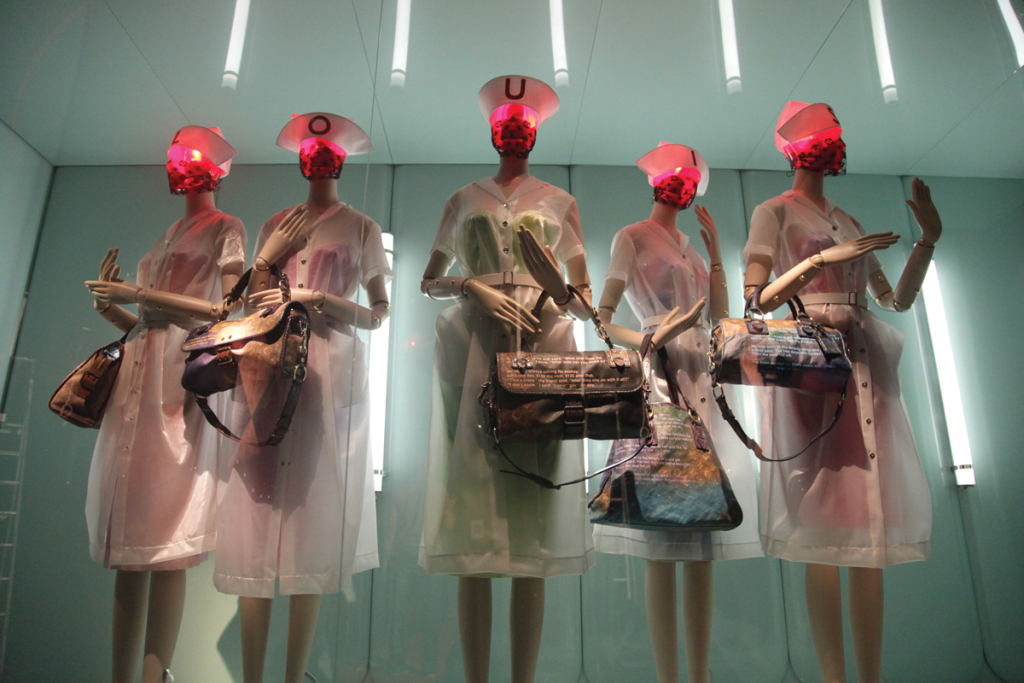 Jokes series handbags designed by Richard Prince and transparent dresses, on view at the “Louis Vuitton–Marc Jacobs” exhibition at the Musée des Arts Décoratifs, Paris, 2012. Courtesy Louis Vuitton/Fairchild Archive/Penske Media
Jokes series handbags designed by Richard Prince and transparent dresses, on view at the “Louis Vuitton–Marc Jacobs” exhibition at the Musée des Arts Décoratifs, Paris, 2012. Courtesy Louis Vuitton/Fairchild Archive/Penske Media
As the world of art broadens its borders and sets its sights on all realms of culture, ARTnews surveyed collaborations of various kinds for the September-October issue of the magazine. Stay tuned as roundups related to different categories—Art x Fashion, Art x Music, Art x Science, Art x Food, and Artists x Artists—join related feature stories online in the weeks to come.
Gucci Ghost x Gucci
“Good artists borrow. Great artists steal,” Picasso famously said. Had he been alive to see the collaboration between street artist Trevor Andrew, aka Gucci Ghost, and Gucci, he might have added that clever artists (or brands, as it were) steal back. Around 10 years ago, Andrew started incorporating the Gucci logo—those iconic interlocking Gs originally created way back in the 1930s by one of Guccio Gucci’s sons—into the graffiti he sprayed on walls, clothes, furniture, dumpsters, and what-have-you, and he noticed it had a certain effect. “I thought it was fascinating how people would take a photo next to a trash bin just because I put the signature Gucci G’s on it,” he recently told Ocean Drive magazine.
Gucci Ghost figured he would keep at it until, as he once put it, the brand either sued him or hired him. In 2016 Gucci creative director Alessandro Michele invited him to collaborate on the Fall collection, giving him a studio to work in and, ultimately, a world tour. Of the 80 resulting pieces—a mix of clothing and accessories emblazoned with the logo in a graffiti scrawl, along with other flourishes like stars and streaks—Andrew, who these days is still making art (and NFTs), has said his favorites included textile patterns for a pleated red and cream skirt and for a series of bomber jackets in different fabrics and colorways, and the Real bag, a tote embossed with the name Gucci, the word real scrawled across it in dripping “paint.”
Jill Magid x Evan Yurman
When conceptual artist Jill Magid met Evan Yurman—son of David Yurman, founder of the eponymous designer jewelry brand—she knew she’d found a kindred spirit. “He had me meet him at his offices on Canal Street and gave me a tour,” she said. “He was really proud of his father’s drawings and sculptures. He learned to manipulate objects when he was little. The idea that there was an art and jewelry crossover was really exciting.”
 Artist Jill Magid and jeweler Evan Yurman collaborated on turning Magid’s public art project Tender into a necklace. Courtesy David Yurman
Artist Jill Magid and jeweler Evan Yurman collaborated on turning Magid’s public art project Tender into a necklace. Courtesy David Yurman
By that point, Magid and Yurman had already started discussing a collaboration in which he would turn the copper penny that Magid designed for her public art project Tender into a necklace. This past September, with support from the public art organization Creative Time, Magid had 120,000 pennies (equal to the number in a $1,200 stimulus check the U.S. Government distributed as pandemic relief) engraved on the perimeter edge with the appropriated phrase “the body was already so fragile,” and rolled in red-and-white wrappers; the coins were circulated mainly through New York City bodegas. Shortly after releasing the pennies, she knew she wanted to turn Tender into a jewelry project, and her friend Selby Drummond, a former jewelry editor at Vogue, introduced her to Yurman.
“Coming from a family of artists—David is a sculptor and my mother is a painter—I connected with Jill’s project immediately,” Yurman said. “I approached the project from a craftsmanship and design perspective, with the objective of bringing Jill’s conceptual work to life in jewelry.”
Initially, Magid was concerned that some of the more conceptual elements of her work would prove difficult to translate, but Yurman and his team made it all possible. “It felt like a true collaboration in that they helped bring my idea to fruition,” Magid said. “They didn’t set annoying parameters, and they accepted and even embraced the inversion of the text on the coin.”
For a very personal reason, Magid wanted the coin amulet to hang over its wearer’s heart: when he was little, her son swallowed a penny that showed up there in an X-ray. “I’m not a huge jewelry wearer,” Magid said, “but I do get very attached to certain pieces”—like the pinkie ring she bought at the gift shop of the Casa Barragán in Mexico City, the preserved home of the architect Luis Barragán, right before proposing a project to the museum. That project went forward, and the pinkie ring became a good luck charm. (In 2016, Magid had some of Barragán’s ashes turned into a diamond and set into an engagement ring inscribed with the text “I am wholeheartedly yours.”)
Yurman and his team reproduced Magid’s coin in 18K rose gold “to emulate the copper of a U.S. penny,” he said. In the limited-edition version, the pendant penny spins within a circular gold frame edged with ruby and diamond baguettes, evoking the red-and-white wrappers.
Magid credits Yurman with picking up on details in the coin-to-necklace transformation that might have eluded her. Yurman pointed out that, like a real penny, the up side was reversed when turned from right to left. “It was really this beautiful question,” Magid said. They decided together to alter the coin so that both heads and tails appear right side up. “The penny is being transformed from its role in commerce into a wearable gadget for the body,” Magid said, “so it was OK to change the orientation.”
Salvador Dalí x Elsa Schiaparelli
When the Salvador Dalí Museum in St. Petersburg, Florida, presented the 2017 exhibition “Dalí & Schiaparelli, In Daring Fashion,” Vogue magazine proposed that back in the 1930s, the two artists had “invented the art/fashion collaboration,” adding that “the irony—the mix of high and low materials, and the multimedia promotional materials that they pioneered—are still used by artists and designers today.” As the O.G. art/fashion project, Dalí + Schiaparelli brought us the Shoe hat, the Lobster dress, the Tears dress, and the Skeleton dress. In retrospect, the results of their collaboration presaged any number of improbable wearables, from Isabella Blow’s wacky hats to Alexander McQueen face masks to Irene Luft’s gas masks, as well as runway stunts like Gucci models carrying replicas of their own heads and Rick Owens models bearing the weight of another model’s body wrapped around their own. More important, they proved that the human body could be a terrific medium for art of its own kind.
Hank Willis Thomas x Helmut Lang 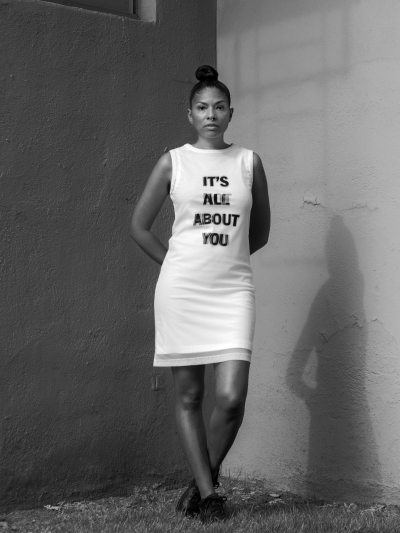 Artist Wildcat Ebony Brown wearing an item from Hank Willis Thomas’s Summer 2021 collaboration with Helmut Lang. Courtesy Hank Willis Thomas
Artist Wildcat Ebony Brown wearing an item from Hank Willis Thomas’s Summer 2021 collaboration with Helmut Lang. Courtesy Hank Willis Thomas
Hank Willis Thomas has used text in his work from the beginning, wielding words to political effect: for a billboard in Pearl, Mississippi, in 2016, he set Donald Trump’s campaign slogan “Make America Great Again” against an image from the 1965 Selma Civil Rights campaign. Earlier this year, he teamed with fashion brand Helmut Lang to present one of his most provocative texts in a whole new way: he released a 10-piece limited collection—featuring hoodies, T-shirts, and a dress—based on his signature 2010 work that uses lenticular printing to render a slogan that reads, depending on vantage point, either IT’S ALL ABOUT YOU or IT’S NOT ABOUT YOU.
Helmut Lang managed to re-create the lenticular effect on the garments, resulting in wearable conversation pieces. And true to Willis Thomas’s commitment to social and political causes, 15 percent of the proceeds from sales go to the prison reform organization Incarceration Nations Network.
This isn’t the first time Willis Thomas has collaborated with a fashion brand. Last year, with Equator Productions, he created a campaign for the 2021 Pre-Spring and Men’s Spring/Summer collections of Chitose Abe, creative director and founder of Japanese fashion house Sacai. For that project, Willis Thomas brought in his own team—including musicians Keyon Harrold and Jason Moran, and artist Zoë Buckman—to create a film. Nor is it the first time Helmut Lang has done the same. Before working with Willis Thomas came collaborations with Carrie Mae Weems, Jeremy Deller, Josephine Meckseper, and—in one of the most iconic partnerships in art/fashion history—Vanessa Beecroft. Back in 2001, Lang designed black thigh-high boots for a Beecroft performance-cum-endurance test at the Kunsthalle Wien entitled “VB45,” in which models stood naked, save for those boots, in military formation until, exhausted, they lay down on the floor.
For his part, Willis Thomas seems likely to continue experimenting in the same vein. Of his project with Helmut Lang, he told WWD, “I have always been obsessed with how fashion and branding shape our perspective of others and ourselves.”
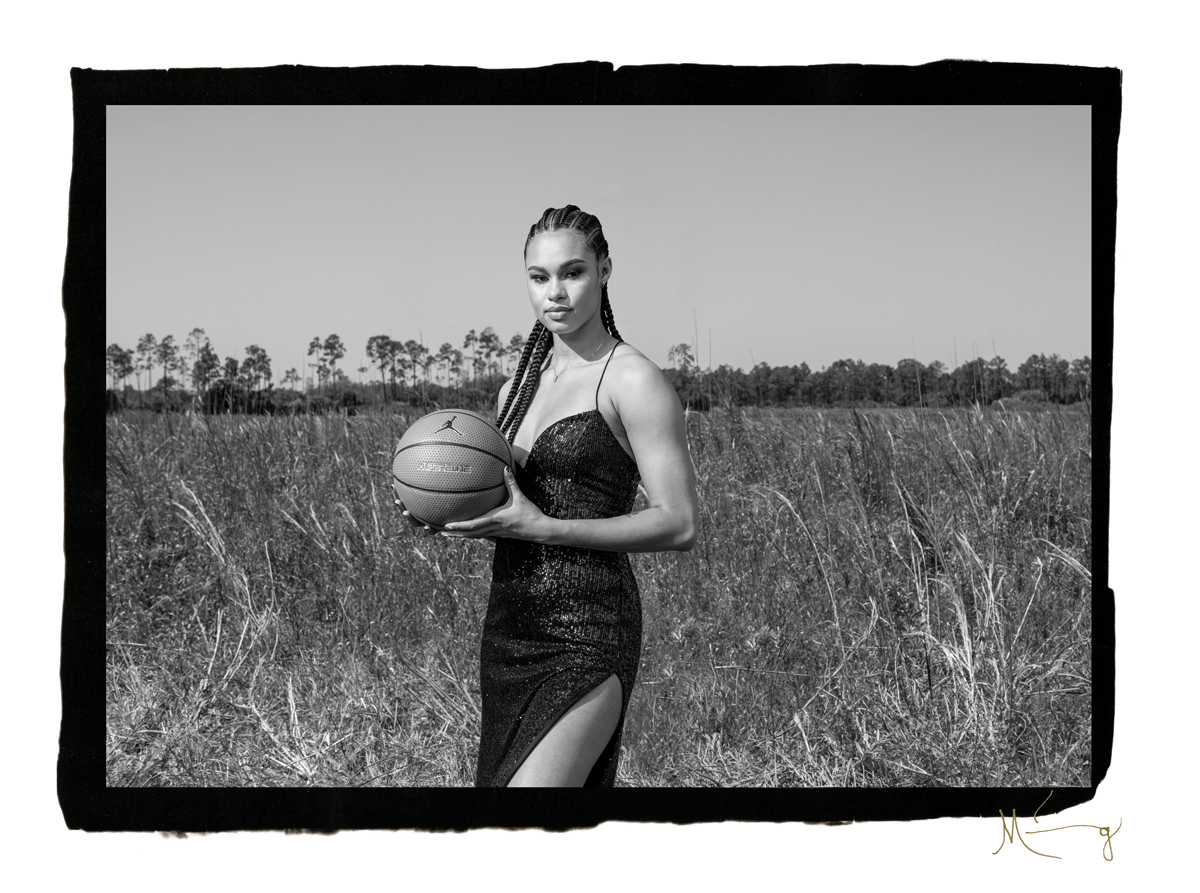 Nike’s Jordan Brand had Ming Smith photograph WNBA player Satou Sabally. Courtesy Jordan Brand/Nike Ming Smith x Nike
Nike’s Jordan Brand had Ming Smith photograph WNBA player Satou Sabally. Courtesy Jordan Brand/Nike Ming Smith x Nike
In a recent interview with her gallerist Nicola Vassell, Ming Smith compared her photography technique to a certain shot in basketball: “The power of anticipation and the patience to wait for what’s coming—it’s like a basketball player hitting three-pointers: practice, repeat, practice, repeat. You get better, and still you’ll miss a few. In photography, you have to nail it the moment it’s in the lens. Take the shot when you see it.”
For the 25th anniversary of the Women’s National Basketball Association, Smith had the chance to shoot some of the players known for sinking those three-pointers. Earlier this year, with Vassell’s help as creative director, Nike’s Jordan Brand brought Smith in to photograph members of the Jordan Brand family who, together, represent the largest group of female athletes Jordan has ever endorsed. Included are portraits of Minnesota Lynx guard Crystal Dangerfield, Phoenix Mercury guard Kia Nurse, Dallas Wings forward Satou Sabally, and others. In the series, the athletes are almost all clad in black, in both individual and group shots, in which they flank Michael Jordan himself.
Known for employing a wide range of techniques to produce ethereal images dating back to the early ’70s, Smith is the only female member of Kamoinge, a collective of Black photographers founded by Roy DeCarava. On the subject of representing the athletes, Smith told i-D magazine, “Empowering images are not stereotypical. Our mothers didn’t have to show huge cleavage, but they were very female. They were women. We are women. So just their beauty is beautiful to me inside and out. It’s the physical and spiritual … the spirit.”
Richard Prince x Louis Vuitton
Over the past two decades, Louis Vuitton has become synonymous with artist collaborations. Working backward, there was a line of bags, scarves, and small leather goods in 2017 based on Jeff Koons’s “Gazing Ball” series, which appropriated famous paintings by the likes of Leonardo da Vinci, Vincent van Gogh, and Claude Monet. In 2012, Vuitton creative director Marc Jacobs, an art collector himself, went all-out on then 82-year-old Yayoi Kusama, splashing her signature polka dots on not just clothing and accessories but all over the brand’s New York flagship store. And then there was the ultimate “it bag,” a 2003 collaboration with Japanese superstar Takashi Murakami. Their eye-popping, anime-like designs brought them untold popularity, so it’s no surprise the collaboration continued for a full 15 years through several collections.
While all such collaborations proved fruitful, Jacobs’s work with Richard Prince in 2008 takes the cake. By the time of his 2007 retrospective at the Guggenheim Museum, Prince’s “Nurse” paintings based on the covers of old pulp fiction paperbacks were selling at auction for millions. Inspired by the exhibition for his Spring/Summer 2008 collection, Jacobs sent 12 supermodels—including Naomi Campbell and Natalia Vodianova—down the runway wearing diaphanous nurse get-ups and black lace LV-monogrammed face masks; they carried bags emblazoned with other Prince works and wore nurse caps that collectively spelled out “Louis Vuitton.”
In February 2020, with Covid starting its deadly global rampage, Jacobs posted a photo grid of the models on Instagram, along with the message, “Wish I’d … held on to one of these. Louis Vuitton Spring 2008 Monogram lace face mask. #justsayin’ #FASHIONNURSE #richardprince.”
Stella McCartney x Various Artists 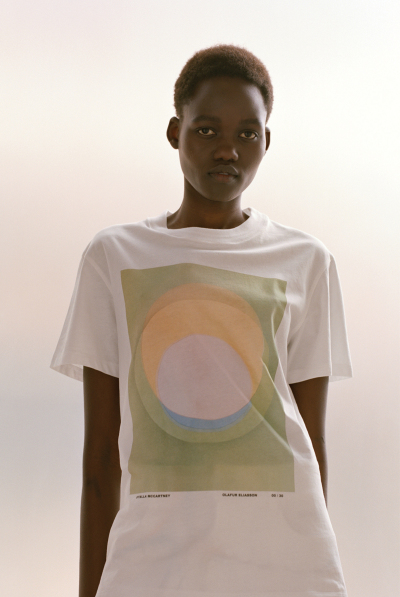 “O Is for Organic” T-shirt from the “A to Z Manifesto” line, based on Olafur Eliasson’s sculpture Imaginary morning eclipse, 2020. Courtesy Stella McCartney
“O Is for Organic” T-shirt from the “A to Z Manifesto” line, based on Olafur Eliasson’s sculpture Imaginary morning eclipse, 2020. Courtesy Stella McCartney
“I find I am most energized when I immerse myself in a collaborative environment where ideas can feed off each other creatively.” So said Stella McCartney about the long list of artists with whom she has worked.
Her second iteration of “Shared,” a capsule collection conceived as a “youthful, genderless exploration of an international collective linked by shared styles and activist values,” features the work of Japanese artist Yoshitomo Nara. For her Spring 2021 collection, based on an “A to Z Manifesto” that paired letters of the alphabet with progressive ideas (M for Mindful, R for Repurpose, etc.), she drew inspiration from a starry list of blue-chip names including Rashid Johnson, Jeff Koons, Sheila Hicks, Cindy Sherman, George Condo, Olafur Eliasson, William Eggleston, and others whose work she has followed since growing up around art with parents Paul and Linda McCartney.
“One memorable moment was from my Winter 2020 collection,” she recalled of working in her favored way. “I met Erté, who is an incredible artist, at a young age on an airplane with my parents. I have always admired his work and never imagined I would have the opportunity to collaborate with him. However, many moons after that first meeting, I was lucky enough to incorporate some of his never-before-seen archival prints for a special show.”
Living in and around art helped guide her eye, McCartney said. “One of my guiding pillars in design is always art. I am constantly drawing inspiration from the art world. Not only does art motivate me to reflect in the present but it can also offer alternate perspectives that bring new realities to life.”
And she sees a promising future for fashion that forges connections to art, and vice versa. “Each time I collaborate with an artist the process is distinctly special,” she said, “and as the worlds of art and fashion continue to intertwine, I firmly believe that one world cannot live without the other.”
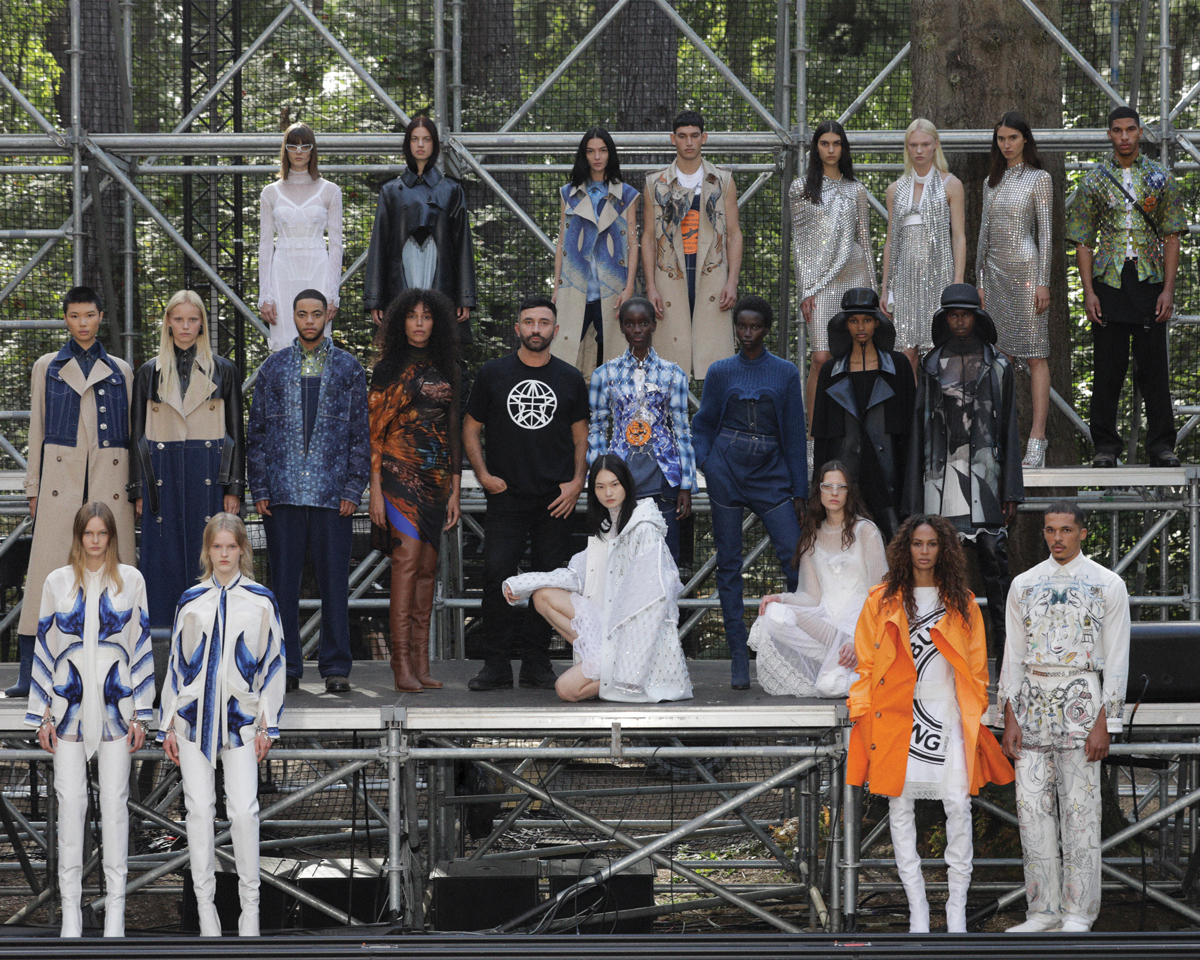 In Burberry’s Spring/Summer 2021 show, a collaboration with Anne Imhof, the models served as viewers of a performance. Courtesy Burberry Anne Imhof x Burberry
In Burberry’s Spring/Summer 2021 show, a collaboration with Anne Imhof, the models served as viewers of a performance. Courtesy Burberry Anne Imhof x Burberry
In spring 2020, the pandemic put a pause on runway shows, and the fashion world turned to short films to present their latest collections. By summer, when Burberry creative director Riccardo Tisci started planning a presentation for Burberry’s Spring/Summer 2021 collection, other designers had already commenced their own outside-the-box thinking about revised formats. In July, for her Spring/Summer 2021 collection, Miuccia Prada showed films by five different artists—Terence Nance, Joanna Piotrowska, Martine Syms, Juergen Teller, and Willy Vanderperre—whom she had asked to “interpret” her designs. Tisci, for his part, decided to reach out to German artist Anne Imhof. “I knew she was someone I could relate to creatively and who could bring a totally unique perspective to the experience I was creating for the show,” he said.
Tisci’s collection was inspired, he says, by an imagined “love affair between a mermaid and a shark,” and numerous garments featured mythological and marine imagery. He and Imhof settled on a remote forest in England as the setting, which he felt signified a return to freedom after months of lockdown. In the film, which debuted during London fashion week this past September, models follow paths leading to a clearing, where they arrange themselves in a circle and serve as an audience to a dance performance with ritualistic undertones. Painter Eliza Douglas, Imhof’s life partner and frequent collaborator, wrote the music for the piece, which is heavy on heavy metal (it features some major headbanging). Imhof’s performers are dressed all in white; she said she sees the film as offering a message of positivity and hope.
Tisci had turned to performance artists before: For his Spring/Summer 2016 collection, he had Marina Abramović place silent performers around his runway show, in what was Imhof’s initial effort directing such a presentation, though she was no stranger to working with a large cast. Her artworks tend to durational performances featuring dancers moving around a space at her direction. Imhof’s art star had been on the rise for a few years before she won its highest accolade in 2017, the Venice Biennale’s Golden Lion, for Faust, a staging in the German Pavilion, in which she choreographed a team of streetwear-clad dancers to move about languidly in the pavilion’s Nazi-era architecture, accompanied by Doberman pinschers.
By that time Imhof had already forged connections to the fashion world through Douglas, who had modeled for Helmut Lang and Balenciaga. In fall 2017, while her work was still on view at the Biennale, Imhof oversaw her first fashion shoot, teaming up with stylist Lotta Volkova for a spread in W magazine that featured Douglas sporting brands like Prada, Calvin Klein, Lanvin, Balenciaga—and Burberry. Imhof said at the time that she was fascinated by the way fashion “is so in the moment but, at the same time, all about taking from history.”
An attraction to a certain period of history is something that Imhof and Tisci have in common. “Anne has this very powerful, distinctive vision and a feeling to her work of something from the late 1990s to the early 2000s,” said Tisci. “We both share a nostalgia and connection to the rawness of that era—its fashion, music, and art.”
As for working together, Tisci said, “it was an amazing collaboration for me, a real exchange of energy and opinion, as I discovered more and more about Anne’s world.” And he plans to continue working in similar ways in the future. “I’m always collaborating with artists,” he said of past projects with artists including Abramović and Kehinde Wiley. “For me, the exchange of different perspectives is how you achieve true openness and freedom in creativity.”
Source link : https://www.artnews.com/art-news/news/art-fashion-collaborations-hank-willis-thomas-anne-imhof-1234603065












